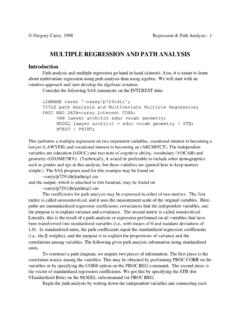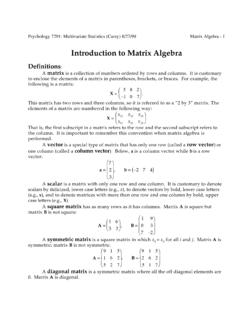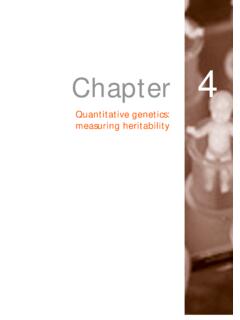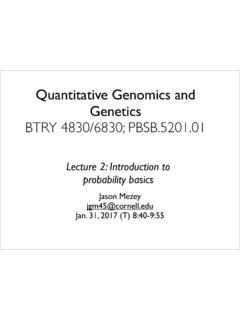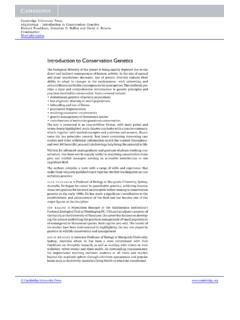Transcription of Quantitative Genetics and Quantitative Traits
1 Gregory Carey, 1998 (incomplete: 10/30/98) Quantitative Genetics - 1 Quantitative Genetics and Quantitative TraitsIntroductionIn the chapter on Mendel and Morgan, we saw how the transmission of genesfrom one generation to another follows precise mathematical formula. The traitsdiscussed in that chapter, however, were discrete Traits peas are either yellow or green,someone either has a disorder or does not have the disorder. But many behavioral traitsare not like these clear-cut, have-it-or-don t-have-it phenotypes. People vary from beingquite shy to very outgoing. But is shyness a discrete trait or merely a descriptiveadjective for one end of a continuous distribution? In this chapter, we will discuss thegenetics of Quantitative , continuously distributed us note first that Genetics has made important albeit not wellrecognized contributions to Quantitative methodology in the social sciences. Theconcept of regression was initially developed by Sir Francis Galton in his attempt topredict offspring s phenotypes from parental phenotypes; it was later expanded andsystematized by his colleague, Karl Pearson1, in the context of evolutionary theory.
2 Theanalysis of variance was formulated by Sir Ronald A. Fisher2 to solve genetic problems inagriculture. Finally, the famous American geneticist Sewell Wright developed thetechnique of path analysis which is now used widely in psychology, sociology,anthropology, and other social Tools: Three StatisticsTo understand Quantitative Genetics , it is important to understand the meaning ofthree basic statistics the mean, the variance, and the correlation coefficient. Themathematics behind each of these three statistics is much less important that theconceptual issues of what they mean is a measure of central tendency or location and answers the question, Around which number do the scores tend to cluster? The mean is the arithmeticaverage and is computed by summing all the scores and dividing by the number variance of a collection of scores is a measure of individual differences aroundthe mean. It is a measure of the degree to which the scores are dispersed away from themean.
3 A variance can range from 0 to a large positive number. A variance of 0 signifiesthat there is no dispersion around the mean every score is the same and every scoreequals the mean. The larger the variance, the more the scores are scattered around important feature of variance is that it can be partitioned. As we will see, thevariance in the phenotype can be partitioned into a portion due to genetic variance andanother portion due to environmental variance. This partitioning helps geneticists toanswer two important questions to what extent are observable individual differences 1 After whom is named the Pearson product moment After whom the F statistic is named. Gregory Carey, 1998 (incomplete: 10/30/98) Quantitative Genetics - 2due to individual differences in genotype and to what extent are observable individualdifferences due to individual differences in the environment?
4 A correlation coefficient is a measure of the extent to which one scores on onevariable can predict scores on a second variable. Mathematically, a correlationcoefficient can range from to There are two important attributes of a correlationcoefficient. The first is the sign of the correlation. A positive sign ( , a correlationbetween 0 and ) denotes a direct relationship. Here, high scores on the first variablepredict high scores on the second variable, and conversely low scores on the secondvariable predict low scores on the second variable. The correlation between height andweight is positive. People who are taller than average tend to (but do not necessary haveto) weigh more than the average person, and people smaller than average in height tend toweigh less than the average person. A negative sign ( , a correlation coefficient less than0) denotes an inverse relationship. In this case, high scores on one variable predict lowscores on the second variable, and conversely low scores on the first variable predict highscores on the second variable.
5 The correlation between the amount of time spent partyingand grades is negative. Students who spend a very large amount of time partying tend toget lower than average grades while students who spend little time at parties tend toreceive higher second important attribute of the correlation is the square of the correlationcoefficient. Because a correlation can range between and , the square of thecorrelation must range between 0 and The square of the correlation is a measure ofthe amount of predictability between the two variables. Statistically speaking, thecorrelation squared gives the proportion of variance in one variable that is predicablefrom the other variable. Because variance is a measure of individual differences, anotherway of stating the previous statement is that the correlation squared is a measure of theextent to which individual differences in one variable are predictable from the secondvariable.
6 If the correlation squared is 0, then there is no predictability the two variablesare not related to each other. If the squared correlation is , then we can perfectlypredict scores on one variable by knowing scores on the second Variation and the Single LocusLet us begin the development of a Quantitative model by considering a single genewith two alleles, a and A. Define the genotypic value ( genetic value) for a genotypeas the average phenotypic value for all individuals with that genotype. For example,suppose that the phenotype were IQ, and we measured IQ on a very large number ofindividuals. Suppose that we also genotyped these individuals for the locus. Thegenotypic value for genotype aa would be the average IQ of all individuals who hadgenotype aa. A hypothetical example is presented in Figure first point to notice about Figure is the variation in IQ around each of thethree genotypes, aa, Aa, and AA.
7 Not everyone with genotype aa, say, has the same reasons for this variation within each genotype is unknown. It would includeenvironmental variation as well as the effects of loci other than the one genotyped. Gregory Carey, 1998 (incomplete: 10/30/98) Quantitative Genetics - 3A second important feature about Figure 1 is that the means of the distributionsfor the three genotypes differ. The mean IQ ( , the genotypic value) for aa is 94, thatfor Aa is 96, and the mean for AA is 108. This implies that the locus has some influenceon individual differences in third feature of note in Figure is that the genotypic value of heterozygote isnot equal to the average of the genotypic values of the two homozygotes. The averagevalue of genotypes aa and AA is (94 + 108)/2 = 101, but the actual genotypic value of Aais 96. This indicates a certain degree of dominant gene action for allele a. Allele a is notcompletely dominant; otherwise, the genotype value for Aa would equal that of , the degree of dominance is fourth feature of importance is that the curves for the three genotypes do notachieve the same height.
8 This is due to the fact that the three genotypes have differentfrequencies. In the calculations used to generate the figure, it was assumed that the allelefrequency for a was .4 and the frequency of A was .6. Hence, the frequency of genotypeaa would be .16, the frequency of Aa would be .48, and the frequency of AA would Consequently, the curve for Aa has the highest peak, the one for AA has the secondhighest peak, and that for aa has the smallest final feature of note is that the phenotypic distribution of IQ in the generalpopulation (the black line in Figure ) looks very much like a normal distribution. Thephenotypic distribution is simply the sum of the distributions for the three example, the height of the black curve when IQ equals 90 is the distance from theFigure Example and notation for the Quantitative genetic analysis of a single ScoreFrequencyaaAaAATotal Gregory Carey, 1998 (incomplete: 10/30/98) Quantitative Genetics - 4horizontal axis to the yellow line when IQ is 90 plus the distance from the horizontal axisto the blue line plus the distance from the horizontal axis to the red line.
9 Often socialscientists mistakenly conclude that the phenotypic distribution must be trimodal becauseit is the sum of three different gene depicted in Figure is currently termed a QTL for Quantitative TraitLocus. Behavioral genetic research devotes considerable effort towards uncovering QTLsfor many different Traits intelligence, reading disability, various personality Traits , andpsychopathology. The mathematical models that quantify the extent to which a QTLcontributes to trait variance are not necessary for us to know. The interesting reader mayconsult the Advanced Topics section at the end of this Variation and Multiple LociSuppose that we could genotype people at another locus for IQ, say the B locuswith its two alleles, b and B. We would now have nine genotypic values as illustrated inTable Once again, we would compute the mean IQ score for all those with agenotype of aabb and then enter this mean in the appropriate cell of the Genotypic values for two could also draw curves for each genotype analogous to the curves depicted inFigure This time, however, there would be nine normal curves, one for eachgenotype.
10 We could continue by adding a third locus with two alleles. This would give27 different genotypes and 27 curves. If we could identify each and every locus thatcontributes to IQ, then we would probably have a very large number of curves. Thevariation within each curve would be due to the model is known as the polygenic model poly for many and genic for special case of polygenic transmission occurs when there are only a few QTLs thatcontribute to a trait. This is called oligogenic transmission (oligo for few). There is notan exact number of loci that distinguish oligogenic from polygenic transmission. Indeed,the mathematics behind oligogenic and polygenic models are identical except for thenumber of loci. At the present time, there is no empirical evidence that gives even aremote glimpse at the number of genes that may be responsible for human quantitativetraits. It may turn out that only five or six QTLs are needed to explain all but a small 3 The phenotypic distribution may be trimodal, but it will be so only when the means for the threegenotypes are very, very different.

